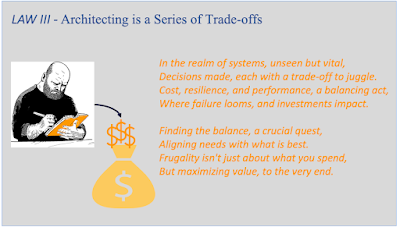Optimize
LAW VI - Cost Optimization is Incremental
Dr. Werner’s Cloud FinOps Insights
The pursuit of cost efficiency is an ongoing journey. Even after deployment, we must revisit systems to incrementally improve optimization. The key is continually questioning and diving deeper. Programming languages provide profiling tools to analyze code performance, and while these require setup and expertise, they enable granular analyses that can lead to changes that shave milliseconds. What may seem like small optimizations accumulate into large savings at scale.
In operations, most time is spent running existing systems. There are opportunities to profile resource usage and identify waste reduction. At Amazon, we continuously monitor services in production to understand patterns and trim inefficiencies. Frugality takes persistence – by incrementally reducing latencies and infrastructure costs, we can optimize the cost to serve.
There is always room for improvement… if we keep looking. The savings we reap today fund innovation for tomorrow.
(excerpt from https://thefrugalarchitect.com/)
Let’s delve deeper
· Cost efficiency is an ongoing process that requires continual improvement.
· Revisiting systems post-deployment helps identify areas for optimization.
· Programming languages offer tools for code analysis, aiding in pinpointing areas for improvement.
· Small optimizations can lead to significant cost savings over time.
· In operations, monitoring resource usage and patterns is crucial for waste reduction.
· Continuous monitoring and optimization help in trimming inefficiencies.
· Persistence in reducing latencies and infrastructure costs leads to optimized service costs.
· Constant improvement ensures that today's savings can fuel tomorrow's innovation.
Apply FinOps principles and AWS Examples
Here's how you can apply FinOps Foundation principles with AWS examples:
- Cost Efficiency through Continual Improvement:
- FinOps Principle: Regularly revisit systems to identify areas for optimization.
- AWS Example: Use AWS Cost Explorer to analyze spending patterns and identify opportunities for cost savings. Regularly review Reserved Instance usage to ensure cost-effectiveness.
- Code Analysis for Optimization:
- FinOps Principle: Programming languages provide tools for code analysis to pinpoint areas for improvement.
- AWS Example: Use AWS CodeGuru to automatically review code and suggest optimizations, leading to more efficient use of resources and potential cost savings.
- Monitoring for Waste Reduction:
- FinOps Principle: Monitoring resource usage and patterns is crucial for waste reduction.
- AWS Example: Use AWS CloudWatch to monitor resource utilization and set up alarms to alert you of any inefficiencies or potential waste.
- Continuous Monitoring and Optimization:
- FinOps Principle: Continuous monitoring and optimization help in trimming inefficiencies.
- AWS Example: Use AWS Trusted Advisor to continuously monitor your AWS environment for cost optimization opportunities, such as underutilized resources or unoptimized configurations.
- Persistence in Cost Reduction:
- FinOps Principle: Persistence in reducing latencies and infrastructure costs leads to optimized service costs.
- AWS Example: Use AWS Lambda for serverless computing, which can help reduce infrastructure costs by running code in response to events without provisioning or managing servers.
- Constant Improvement for Future Innovation:
- FinOps Principle: Constant improvement ensures that today's savings can fuel tomorrow's innovation.
- AWS Example: Use AWS Cost Anomaly Detection to identify anomalous spending patterns and take corrective actions to optimize costs and free up resources for future innovation.
A FinOps Odyssey
LAW VII Unchallenged Success Leads to Assumptions.
Dr. Werner’s Cloud FinOps Insights
When software teams achieve significant success without facing major failures or roadblocks, complacency can set in. There is a dangerous tendency to become overconfident in the methods, tools, and practices that led to those wins.
Software teams often fall into the trap of assuming their current technologies, architectures, or languages will always be the best choice, simply because they have worked in the past. This can create a false sense of security that discourages questioning the status quo or exploring new options which could be more efficient, cost-effective, or scalable.
You see this frequently when it comes to programming languages. “We’re a Java shop” is a phrase I’ve heard too often – and it can stifle innovation. Unchallenged success breeds complacency through assumptions. We must always look for ways to question, optimize and improve.
As Grace Hopper famously stated, one of the most dangerous phrases in the English language is: “We’ve always done it this way.”
(excerpt from https://thefrugalarchitect.com/)
A FinOps Odyssey
Conclusion
In conclusion, "The FinOps Odyssey" series has shed light on the crucial role of FinOps principles in modern cloud architecture. From aligning costs with business models to optimizing resource usage and fostering a culture of continual improvement, each part of the series has highlighted key strategies, best practices and AWS services for achieving cost efficiency and operational excellence in the cloud. By applying the insights gained from this series, businesses can navigate the complexities of cloud cost management more effectively and drive greater value from their cloud investments.









